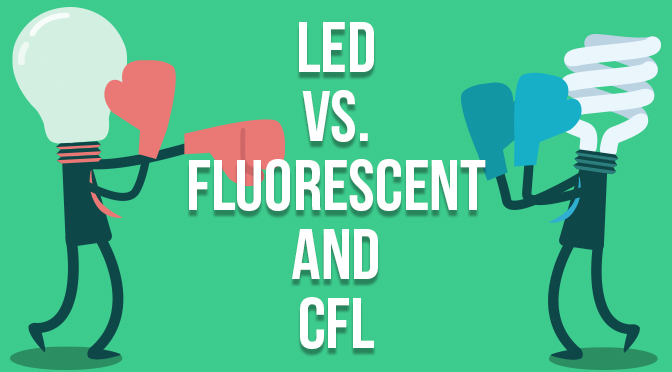
LED, fluorescent, and compact fluorescent lamps (CFL) are some of many lighting technologies that are available today. Knowing the difference between CFL and LED and the difference between fluorescent and LED can help you make an educated decision on what’s best for your application and budget.
Fluorescent lamp/CFL:
An electric current passes through argon and mercury vapors, producing ultraviolet light that activates the phosphor coating inside the bulb and causes it to glow or fluoresce - hence the name fluorescence. CFLS are fluorescent tubes that are coiled into a spiral shape, so they can be used in the same way as incandescent bulbs.
What you should know:
CFL and fluorescent lamps may not work properly at high or low temperatures.
They produce large amounts of ultraviolet (UV) and infrared (IR) radiation, which can damage fabrics and artwork. Fluorescent light bulbs
Fluorescent light bulbs
CFL bulb
CFL bulb
Fluorescent bulbs and CFLS last about 10,000 hours-eight times longer than incandescent bulbs, but they last five times shorter than leds.
They use 20 percent more power than leds, but 75 percent less than incandescent bulbs.
Fluorescent bulbs and CFLS are brittle and contain mercury. If they break, special precautions must be taken. Among other steps, energy star recommends ventilating the room, sealing the bulb contents, and turning off any heating or air conditioning systems.
They can take up to three minutes to reach full brightness.
Because they take time to warm up, turning CFL and CFL fixtures on and off quickly can result in shortened life.
They have a low colour rendering index (CRI) and produce unpleasant yellow-green tones.
Fluorescent bulbs contain ballasts that, unless integrated (as in a spiral CFL), usually fail and need to be replaced.
High CRI LED with CFL spectrum
LED:
Leds produce some of the most durable and energy-efficient lighting today. Electronic-rich semiconductors and hole-rich semiconductors are used to make leds. An electric current passing through the junction between the two materials binds the electrons to the hole and produces a photon, which is what you see. LED lighting has unlimited application possibilities such as under-cabinet, landscape, vehicle, home, industrial and commercial lighting.
What you should know:
Leds operate at much lower temperatures than fluorescent bulbs and do not need higher temperatures to function properly, greatly extending their lifespan and enabling them to operate at lower temperatures.
Unless the LED lamp has a specific infrared (IR) or ultraviolet (UV) radiation, it produces little or no infrared or ultraviolet radiation, which can cause damage to fabrics and artwork.
They can last up to 50,000 hours - five times longer than a CFL.
Compared to all other lighting technologies, the power consumption is the lowest - 20% lower than fluorescent bulbs.
Examples of LED bulbs
LED bulbs
LED lights are free of mercury, harmful gases or toxins.
Many of these bulbs are shatterproof and shockproof.
Unlike fluorescent bulbs and CFLS, which illuminate immediately, they can take minutes to reach full brightness.
LED lights require a higher initial investment, but they are the best value because of their energy efficiency and longer life.
They come in many different whites and colors.
Because of their low power consumption, LED lights are an excellent alternative lighting solution for solar systems.
led lights,solar lights,led strip lights,Deck Lights,WIFI Deck Lights,WIFI LED Strip